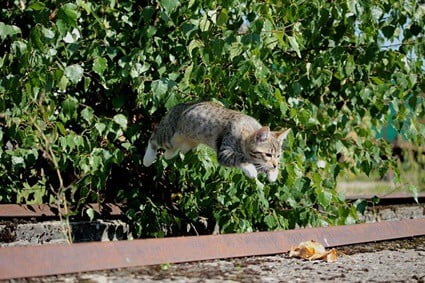Why Can Cats Jump So High?
Cats have evolved over thousands of years to be quiet, agile mesopredators. They have become skilled at jumping up trees by chasing small prey animals and running away from larger predators.
Cats’ ability to leap is mostly due to their back legs. They’re powerful and act as a spring when a cat’s ready to jump. Their hind legs are more powerful than the front legs. There’s not much bone density in them either, giving cats superior jumping skills.
The spine is an essential part of a cat’s jumping prowess. A cat’s spine has 53 vertebrae, giving them increased flexibility. Also, there are elastic discs between the vertebrae, which cushions their landing.
Cats have quick-twitch muscle fibers, which means that if a predator or threat is nearby, they can respond quickly and jump several feet within seconds to escape.

Should You Let Your Cats Leap Around?
Many pet owners worry that letting cats leap around too much might be bad for them. If you’ve ever watched a kitten make their first few shaky leaps (and the first dozen, and the first hundred, frankly), you’ll probably understand where this concern comes from.
It’s easy for cats to miscalculate, jump onto a space that isn’t quite big enough, or decide that your grandmother’s vase doesn’t need to be on that particular shelf.
However, your feline friends need to spend a little time leaping around, just like it’s important for them to spend some time sleeping, stretching, eating, and running.
Domesticated cats don’t get nearly as much exercise as their wild counterparts. But they are still designed to be predators and to be relatively active in short bursts. A cat that doesn’t get enough good exercise is a cat that’s likely to be bored, moody, and even downright angry.
Jumping flexes a lot of muscles, and your cat also has to think quite a bit before leaping. The little wigglebutt motion most cats make before they leap is a way to check a ton of information to make sure it’s safe to leap.
While you’re oohing and awing over your cat’s cute behavior, your cat is checking to make sure its muscles are ready to leap, that the surface under it is stable enough for the jump, and lining themselves up to make sure they land where they want to.
All that work is very satisfying to your cat, even if they aren’t making the kinds of gravity-defying leaps that they would in the wild.
Cats carrying too much weight is a common problem. Domesticated cats mostly have access to far more food than their wild counterparts, and need to go to far less effort to get it. Letting your cat leap around and play, especially when they’re starting to pack on a couple of extra pounds, can help them stay slimmer.
While a severely overweight cat probably won’t run and jump as much, using a toy that will help them jump and run while they play can help them lose some weight.
Is it OK for my dog to jump?
While most dogs are capable of jumping several times their own height, it doesn’t mean they always should. Puppies shouldn’t be asked to jump in extreme or competitive situations until they’re at least 12-15 months old (or older for giant/slow-maturing breeds).